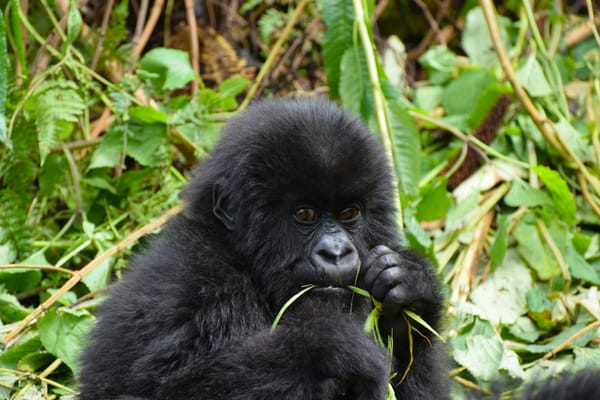Guerrilla marketing is an unconventional and creative form of marketing that relies on innovative, low-cost strategies to promote a product, service, or brand. The term "guerrilla" is derived from guerrilla warfare, emphasizing the unconventional and surprising nature of these marketing tactics.
Unlike traditional marketing methods, guerrilla marketing often looks to engage the audience in unexpected ways, leveraging creativity and imagination to make a lasting impression.
In this article, we’re going to dive deeper into the wonders of guerrilla marketing, looking at the exciting ways in which you can bring your marketing campaigns to life without breaking the bank.
- Characteristics of guerrilla marketing
- Types of guerrilla marketing - real-life examples included
- How is guerrilla marketing relevant to revenue marketing?
- Tips for implementing guerrilla marketing

Characteristics of guerrilla marketing
There are specific characteristics of guerrilla marketing that help make it what it is. Understanding and embodying these characteristics can empower you, as a revenue marketer, to develop guerrilla marketing campaigns that not only capture attention but also contribute to increased brand awareness and, ultimately, revenue growth.
Low-cost tactics
Creativity over budget: Unlike traditional marketing, guerrilla marketing relies more on creativity and innovation than on a large budget. It's about finding unique and cost-effective ways to promote a product or service.
Resourcefulness: Brands often leverage existing resources creatively, turning everyday elements into marketing tools. This characteristic allows small businesses to compete with larger competitors without those hefty financial investments. Which is perfect when your marketing budget is reduced.
Unconventional approaches
Breaking the mold: Guerrilla marketing thrives on breaking away from conventional advertising methods. This involves thinking beyond traditional channels like TV or print and exploring unconventional platforms and mediums.
Surprising locations: Choosing unexpected and unconventional locations for marketing activities helps grab attention. For example, projecting advertisements on buildings, using public spaces for installations, or organizing events in unusual locations.

Emphasis on surprise and novelty
Memorable impact: Guerrilla marketing campaigns aim to create a lasting impression on the audience by surprising them. Whether through humor, shock, or awe, the goal is to make the brand memorable.
Novelty factors: Incorporating elements of surprise, humor, or interactivity into campaigns ensures that the audience not only notices but also engages with the marketing message. This novelty is what often makes guerrilla marketing shareable and viral.

Limited duration and scope
Short-term focus: Guerrilla marketing campaigns are often short-lived and designed for specific, timely events or promotions. This adds a sense of urgency and exclusivity, encouraging immediate engagement.

Localized impact: While the reach can be extensive due to the potential for virality, the initial focus is often on localized impact. This can be advantageous for businesses targeting specific geographic areas.
Adaptability and flexibility
Responsive to trends: Guerrilla marketing is agile and can quickly adapt to current trends and cultural shifts. This adaptability ensures that campaigns stay relevant and resonate with the audience.
Flexibility in execution: The flexibility to adjust strategies based on real-time feedback allows marketers to optimize their approaches for maximum impact.
Risk-taking and boldness
Embracing risks: Successful guerrilla marketing often involves taking calculated risks. Brands that are willing to step outside their comfort zones and challenge norms are more likely to capture attention and stand out.
Bold creativity: Being bold and daring in creative expressions can set a brand apart from competitors. This characteristic encourages marketers to push boundaries and create memorable experiences.
Types of guerrilla marketing - real-life examples included
Ambient media
Ambient media is a form of guerrilla marketing that involves placing advertisements in unexpected and unusual places, such as sidewalks, park benches, or even restaurant napkins. The goal is to capture attention in unexpected moments, leaving a lasting impression on passersby.
A real-life example of ambient media
In 2012, Coca-Cola executed a unique ambient media campaign in Singapore. At the National University of Singapore, they delivered an interactive “hug me” vending machine that dispensed free Coca-Cola when someone gave it a hug.
The campaign not only surprised students but also turned a mundane space - with potentially quite home-sick and lonely students - into a joyful experience, creating a memorable connection with the brand.
Guerrilla projections
Guerrilla projections take advertising to a new level by projecting images or messages onto the sides of buildings or public spaces. Often done during the night for maximum visibility, this tactic aims to captivate audiences in high-traffic areas with dynamic and attention-grabbing visuals.
A real-life example of guerrilla projections
Adidas used guerrilla projections to promote their new soccer boots. They projected a life-sized image of Lionel Messi, one of their brand ambassadors, onto the side of a building in Barcelona. Passersby were captivated by the dynamic display, creating a buzz around the product and generating social media shares.
Street marketing
Street marketing, another guerrilla tactic, employs teams of people to engage directly with consumers on the streets. This could involve distributing product samples, and coupons, or engaging in conversations about the brand. By creating a personal and direct connection, street marketing aims to generate immediate interest and engagement.
A real-life example of street marketing
To promote the release of the 2013 movie "Carrie," a horror film, a telekinetic coffee shop stunt was set up in New York City. The setup involved a hidden camera capturing the reactions of customers as a girl seemingly unleashed her telekinetic powers in a coffee shop.
The video went viral, generating significant buzz around the movie and showcasing the power of street marketing to create memorable and shareable experiences.
Stunts and flash mobs
Stunts and flash mobs are about orchestrating unexpected and attention-grabbing events in public spaces. These can involve a group suddenly appearing to perform or interact with passersby, creating a spectacle that draws attention to the brand.
Product sampling
Product sampling is a straightforward guerrilla marketing tactic where free product samples are distributed in busy public places. Allowing consumers to experience the product firsthand can significantly impact brand perception and drive immediate interest.
Real-life example of product sampling
Ben & Jerry's is known for its creative product sampling. In addition to traditional methods, they have employed quirky tactics like setting up a pop-up booth for a “human claw” game offering free samples of their new ice cream flavor. This not only provides a taste of their ice cream but also adds an element of fun and surprise.
Interactive campaigns
Interactive campaigns involve setting up displays or activities in public spaces, encouraging consumers to interact directly with the brand. This form of engagement captures attention and creates a memorable experience that associates positive feelings with the brand.
A real-life example of interactive campaigns
To promote the release of the horror movie "Smile", they had performers stand at different, crowded sports events in various cities, smiling creepily at the camera. The best part of this was that they would go unnoticed for a while until attention was gradually entirely on them.
The sports fans could interact with the person, taking photos and sharing them on social media, and the actor would continue smiling unflinchingly. This interactive campaign effectively built anticipation for the horror movie due to the unnerving nature of the act.
Uh, welcome to Oakland? pic.twitter.com/Zn6mu45t5P
— SNY (@SNYtv) September 24, 2022
Undercover marketing
Undercover marketing takes a different approach by hiring actors or brand ambassadors to interact with consumers without revealing their association with the brand. This creates an authentic and unexpected experience, fostering a connection with the audience.
You can, again, see an example of this with the film “Smile”, as the actors interacted with people, who were unsure that it was a film stunt until news outlets began to report on the campaign.
Viral content
Finally, viral content focuses on creating entertaining or humorous online videos, ads, or campaigns designed for organic sharing on social media platforms. Leveraging the power of virality, this tactic can exponentially increase brand visibility and engagement.
Real-life example of viral content
Dollar Shave Club's launch video is a classic example of guerrilla marketing through viral content. The CEO, in a humorous and unscripted video, explained the company's value proposition, and the video went viral, reaching millions of views. This unconventional approach helped the brand gain widespread attention and customers.
How is guerrilla marketing relevant to revenue marketing?
Guerrilla marketing and revenue marketing are two distinct but interconnected concepts in the realm of marketing. Guerrilla marketing often serves as a creative and unconventional approach to engage audiences and create buzz, while revenue marketing is more focused on driving measurable and tangible financial results for a business.
They are relevant to each other in terms of:
- Increased visibility and brand awareness
- Effective audience engagement
- Alignment with brand values
- Measurable impact
- Conversion and sales funnel impact
Essentially, while guerrilla marketing may not directly generate revenue in the immediate term, its impact on brand awareness, engagement, and customer perception can have significant implications for revenue marketing efforts.
When these two approaches are aligned strategically, they create a powerful synergy that contributes to both short-term and long-term financial success for a business.
Tips for implementing guerrilla marketing
Implementing successful guerrilla marketing involves a strategic approach encompassing several key elements. So, let’s get into them.
Understand your audience
First and foremost, understanding your audience is paramount. In-depth research into the demographics, behaviors, and interests of your target market is crucial for tailoring guerrilla tactics effectively.
By dividing your audience into segments based on various factors, you can create more personalized and targeted strategies that resonate with specific groups.
Align with brand values
Equally important is aligning guerrilla tactics with your brand's values. Consistency is key in this regard, ensuring that the unconventional marketing methods seamlessly integrate with your brand's identity.
By doing so, you not only reinforce your brand's core messages but also build trust and credibility among your audience. This alignment is essential for creating a memorable and cohesive brand experience through guerrilla campaigns.
Measure impact
Measuring the impact of guerrilla marketing is another critical aspect of a successful strategy. Utilize tracking tools and analytics to monitor online and offline channels, gauging audience reactions and engagement.
Establishing key performance indicators (KPIs) that align with your campaign objectives allows you to quantify success. Tracking these metrics provides valuable insights into the effectiveness of your guerrilla marketing efforts and helps in making data-driven decisions for future campaigns.
Translate engagement into tangible revenue metrics
Above all else, translating engagement into tangible revenue metrics is the ultimate goal. Implement attribution models to understand how different touchpoints contribute to conversions. Analyze the customer journey from awareness to purchase, identifying key points where guerrilla marketing positively impacts conversion rates.
Consider the long-term value of customers acquired through these campaigns by calculating Customer Lifetime Value (CLV), providing a comprehensive understanding of the impact on revenue over an extended period.
Final thoughts
Guerrilla marketing opens up endless possibilities for creatively promoting a brand. With some imagination and innovation, marketers can grab attention and make a lasting impact without a huge budget.
The unconventional nature of guerrilla tactics allows for memorable and disruptive messaging. While risky, this inventive approach can provide big rewards. The future of marketing belongs to those willing to think outside the box.
Do you have any real-life examples of guerrilla marketing campaigns that you think hit it out of the park? Let us know in our Slack community, or on LinkedIn!



 Follow us on LinkedIn
Follow us on LinkedIn



